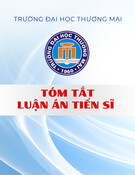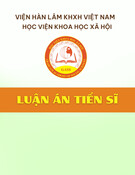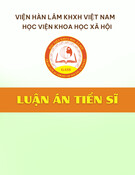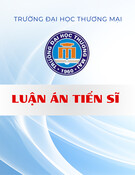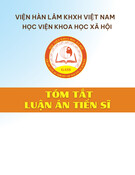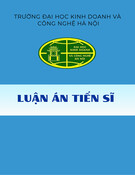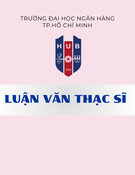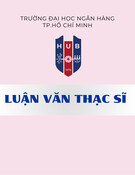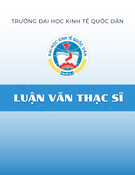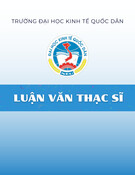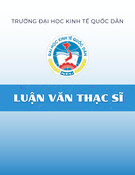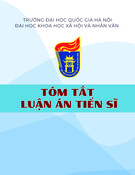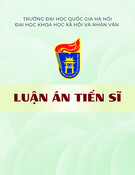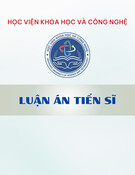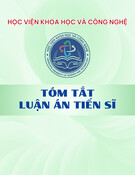
VIETNAM ACADEMY OF SOCIAL SCIENCES
GRADUATE ACADEMY OF SOCIAL SCIENCES
TRAN THI VAN ANH
VIETNAMESE TEXTILE AND GARMENT
ENTERPRISES IN THE CONEXT OF THE
FOURTH INDUSTRIAL REVOLUTION
TÀI THỦY-BỘ
NỘI ĐỊA Ở ĐỒNG BẰNG SÔNG CỬU LONG
Concentration: Development Economics
Code: 9.31.01.05
SUMMARY OF DOCTORAL THESIS
HA NOI – 2019

This doctoral thesis is accomplished at:
GRADUATE ACADEMY OF SOCIAL SCIENCES
VIETNAM ACADEMY OF SOCIAL SCIENCES
Academic advisors:
1. Dr. Phi Vinh Tuong
2. Dr. Duong Dinh Giam
Reviewer 1: Prof. PhD. Do Duc Binh
Reviewer 2: Assoc. Prof. PhD. Vu Hung Cuong
Reviewer 3: Assoc. Prof. PhD. Nguyen Van Thao
This doctoral thesis is to be defended before the Thesis Defense Committee
of the Graduate Academy of Social Sciences,
at: Graduate Academy of Social Sciences, 477 Nguyen Trai, Thanh Xuan,
Hanoi
Time: Date:
Archived at:
- Library of the Graduate Academy of Social Sciences
- Vietnam National Library

1
INTRODUCTION
1. Research justification
Textile and garment enterprises in Vietnam have been utilizing most
of development opportunities brough about by international economic
integration, particularly after Vietnam’s official membership of the World
Trade Organization (WTO). The developtment of Vietnam’s textile and
garment enterprises have contributed to the increase of earnings in foreign
currency and the textile and garment export turnover, which climbed from
USD 5.85 billion in 2006 to USD 36.14 billion in 2018, seven times bigger
after one decade. This development reflected more clearly in the export
structure of Vietnam’s textile and garment industry. Besides garment
products as the main export, the textile and garment enterprises have traded
internationally products such as fibers, fabrics, textile materials or non-
woven fabrics. The total export value of fibers, fabrics or textile materials
in 2018, which were were respectively USD 3.95 billion, USD 1.66 billion
and USD 1.23 billion, was higher than the total export value of 2006.
The development of textile and garment enterprises have also
increased the labor demand. In recent years, the textile and garment labor
force has accounted for more than 20% of the total employment in
manufacturing and nearly 5% of the country’s labor force. The industry in
2017 created about 2.5 million jobs, of which 80% were for female
workers.
With such development, the textile and garment industry has been
contributing to the process of industrialization and modernization, the
transformation of economic and labor structures, and economic growth.
Morever, the growth of textile and garment enterprises also acts a buffer for
the economy against shocks due to negative impacts of international or
domestic crises. Even in the period of economic crisis, Vietnam’s textile
and garment export turnover reached USD 9.12 billion in 2008 and USD
9.07 billion in 2009, higher than that of 2006 and 2007.
Despite such contribution to Vietnam’s economic achievements,
textile and garment enterprises face certain obstacles in development.
These have been the focus of many studies, such as investment
mobilization for production expansion, technological renovation, labor
quality and fluctuation of labor number, limited capacity for research and

2
development (R&D), or barriers in evlevating to higher value-added phases
of the global value chains.
While the aforementioned development issues are still being
addressed, the fourth industrial revolution taking place in recent decades
continues to pose new development challenges and issues for Vietnam’s
textile and garment enterprises. Under the influence of the fourth industrial
revolution or Industry 4.0 (hereinafter referred to as Industry 4.0), the
technology and methods for textile and garment production would have
fundamentally changed, not only for the matter of how to produce but also
to produce for which market sizes thanks to the application of new internet-
based technologies.
More than ever, enterprises in developed economies with the early
application of the achievements of Industry 4.0 and international economic
integration have gain advantages and posed challenges for businesses in
developing and transitioning economies, including Vietnam. While the role
of textile and garment enterprises in the process of industrialization and
modernization in developing and transitioning economies is undeniable,
promoting the development of these enterprises faces increasing
difficulties.
In order to reach the goals of industrialization and modernization in
the context of Industry 4.0, the continued promotion of Vietnamese textile
and garment enterprises is necessary because of its important roles in the
economy in terms of job creation, contribution to the state budget,
transformation of economic structure, and as a buffer against the shocks
caused by structural changes and integration. With that important role of
textile and garment enterprises and challenges brought by Industry 4.0, the
author selected the topic of “Vietnam Textile and Garment Enterprises in
the context of the Fourth Industrial Revolution” for a doctoral thesis.
2. Rationale and research objectives
2.1 Rationale
The aim of the thesis is to clarify the development issues of
Vietnamese textile and garment enterprises in the context of the ongoing
Industry 4.0 and propose a number of textile and garment enterprise
development solutions.
2.2 Research objectives

3
The thesis aims at specific research objectives as follows:
- To identify some theoretical issues on enterprise development,
focusing on determinant factors to the development of textile and garment
enterprises in the context of Industry 4.0; to draw some practical lessons
learned from the practices of textile and garment development in some
countries.
- To assess the current development situation of Vietnam’s textile
and garment enterprises in the period of 2007-2018 in order to identify
some development issues; to analyze strengths, weaknesses, opportunities
and threats facing these enterprises in the context of Industry 4.0.
- To propose some solutions for the development of textile and
garment enterprises in the context of Industry 4.0 from the author’s
viewpoints.
3. Research focus and scope of study
3.1. Research focus
The research focuses on the development of Vietnamese textile and
garment enterprises in the context of Industry 4.0.
3.2. Scope of study
- The research focuses on the development issues of Vietnamese textile and
garment enterprises within the territory of Vietnam.
- The development issues of Vietnamese textile and garment enterprises
within the territory of Vietnam are studied for the period of 2007-2018
although Industry 4.0 only began in 2014. The proposed solutions are
designed for the period 2020-2025 with vision to 2030.
4. Research approach and methodology
4.1 Research approach
Based on the combination of enterprise and value chain theories, the thesis
assesses the recent development of textile and garment enterprises in
Vietnam and identifies the factors affecting their development; to analyze
opportunities and challenges facing textile and garment enterprises in the
context of Industry 4.0 and to offer specific solutions and recommendations
to promote their development thereby.



